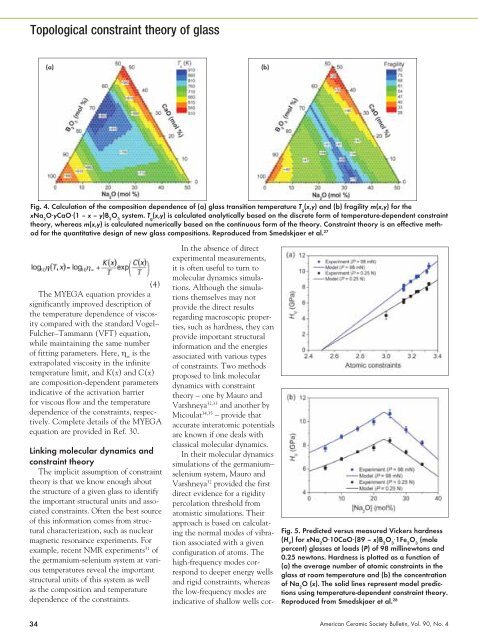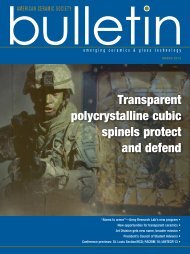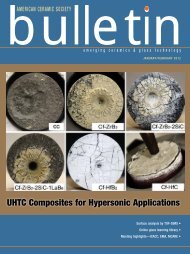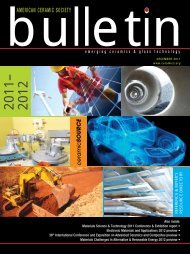American Ceramic Society Bulletin
American Ceramic Society Bulletin
American Ceramic Society Bulletin
You also want an ePaper? Increase the reach of your titles
YUMPU automatically turns print PDFs into web optimized ePapers that Google loves.
Topological constraint theory of glass<br />
(a) (b)<br />
Fig. 4. Calculation of the composition dependence of (a) glass transition temperature T g (x,y) and (b) fragility m(x,y) for the<br />
xNa 2 O⋅yCaO⋅(1 – x – y)B 2 O 3 system. T g (x,y) is calculated analytically based on the discrete form of temperature-dependent constraint<br />
theory, whereas m(x,y) is calculated numerically based on the continuous form of the theory. Constraint theory is an effective method<br />
for the quantitative design of new glass compositions. Reproduced from Smedskjaer et al. 27<br />
(4)<br />
The MYEGA equation provides a<br />
significantly improved description of<br />
the temperature dependence of viscosity<br />
compared with the standard Vogel–<br />
Fulcher–Tammann (VFT) equation,<br />
while maintaining the same number<br />
of fitting parameters. Here, η ∞ is the<br />
extrapolated viscosity in the infinite<br />
temperature limit, and K(x) and C(x)<br />
are composition-dependent parameters<br />
indicative of the activation barrier<br />
for viscous flow and the temperature<br />
dependence of the constraints, respectively.<br />
Complete details of the MYEGA<br />
equation are provided in Ref. 30.<br />
Linking molecular dynamics and<br />
constraint theory<br />
The implicit assumption of constraint<br />
theory is that we know enough about<br />
the structure of a given glass to identify<br />
the important structural units and associated<br />
constraints. Often the best source<br />
of this information comes from structural<br />
characterization, such as nuclear<br />
magnetic resonance experiments. For<br />
example, recent NMR experiments 31 of<br />
the germanium-selenium system at various<br />
temperatures reveal the important<br />
structural units of this system as well<br />
as the composition and temperature<br />
dependence of the constraints.<br />
In the absence of direct<br />
experimental measurements,<br />
it is often useful to turn to<br />
molecular dynamics simulations.<br />
Although the simulations<br />
themselves may not<br />
provide the direct results<br />
regarding macroscopic properties,<br />
such as hardness, they can<br />
provide important structural<br />
information and the energies<br />
associated with various types<br />
of constraints. Two methods<br />
proposed to link molecular<br />
dynamics with constraint<br />
theory – one by Mauro and<br />
Varshneya 32,33 and another by<br />
Micoulat 34,35 – provide that<br />
accurate interatomic potentials<br />
are known if one deals with<br />
classical molecular dynamics.<br />
In their molecular dynamics<br />
simulations of the germanium–<br />
selenium system, Mauro and<br />
Varshneya 32 provided the first<br />
direct evidence for a rigidity<br />
percolation threshold from<br />
atomistic simulations. Their<br />
approach is based on calculating<br />
the normal modes of vibration<br />
associated with a given<br />
configuration of atoms. The<br />
high-frequency modes correspond<br />
to deeper energy wells<br />
and rigid constraints, whereas<br />
the low-frequency modes are<br />
indicative of shallow wells cor-<br />
Fig. 5. Predicted versus measured Vickers hardness<br />
(H V ) for xNa 2 O⋅10CaO⋅(89 – x)B 2 O 3 ⋅1Fe 2 O 3 (mole<br />
percent) glasses at loads (P) of 98 millinewtons and<br />
0.25 newtons. Hardness is plotted as a function of<br />
(a) the average number of atomic constraints in the<br />
glass at room temperature and (b) the concentration<br />
of Na 2 O (x). The solid lines represent model predictions<br />
using temperature-dependent constraint theory.<br />
Reproduced from Smedskjaer et al. 28<br />
34 <strong>American</strong> <strong>Ceramic</strong> <strong>Society</strong> <strong>Bulletin</strong>, Vol. 90, No. 4






